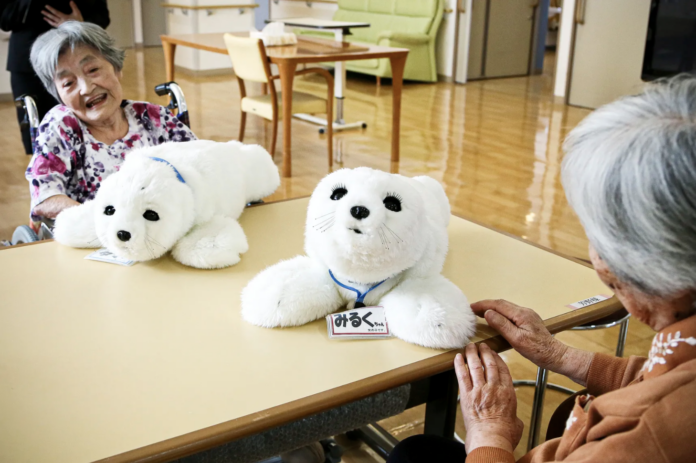Robots designed to play social roles come in many forms. Some seem like little more than advanced mechanical toys, but they have the added capacity to sense their environment and respond to it. Many of these mimic cute animals that issue comforting little barks and meows. Other robots have more humanoid features and talk to you like a person would. ElliQ will greet you with a friendly “Hi, it’s a pleasure to meet you” and tell you jokes; SanTO will read to you from the Bible and bless you; Pepper will play music and have a full-on dance party with you. You can get Secom’s My Spoon robot to feed you, Sanyo’s electric bathtub robot to wash you, and Riken’s RIBA robot to lift you out of bed and into a chair. The most well-studied robot, Paro, comes in the form of a baby harp seal. It’s adorable, but the US has recognized it as more than just that, classifying it as a medical device. In older adults, notably those with dementia, Paro can reduce loneliness, depression, agitation, blood pressure, and even the need for some medications.
Unlike human caregivers, social robots never get impatient or frustrated. They’ll never forget a pill or a doctor’s appointment. And they won’t abuse or defraud anyone. During the pandemic, when we’re all forced to socially distance from other human beings, robots can keep seniors company without any risk of giving them the coronavirus. Although there’s a strong case to be made for using robots in a pandemic, the rise of robot caregiving during the coronavirus crisis raises the possibility of robots becoming the new normal even in non-pandemic times. Replacing or supplementing human caregivers with robots could be detrimental to the person being cared for. For one thing, human contact is already in danger of becoming a luxury good as we create robots to more cheaply do the work of people. Getting robots to take on more and more caregiving duties could mean reducing seniors’ level of human contact even further.
As companies urge us to let their robots care for our parents and grandparents, we might feel like we don’t need to visit them as much, figuring they’ve already got the company they need. That would be a mistake. For many older adults, interacting with a robot would feel less emotionally satisfying than interacting with a person because of the sense that whatever the robot says or does is not “authentic,” not based on real thoughts and feelings. But for those who have no one or very few people to interact with, contact with a robot is probably better than no contact at all. Some particularly well-designed robots, like Paro, have also been shown to increase human-to-human interaction among nursing home residents and between seniors and their kids. It gives them something positive to focus on and talk about together.
Another common worry is that robots may violate human dignity because it can be demeaning and objectifying to have a machine wash or move you, as if you’re a lump of dead matter. But Filippo Santoni de Sio, a tech ethics professor at Delft University of Technology in the Netherlands, emphasized that “For some people, it’s more dignifying to be assisted by a machine that does not understand what’s going on. Some may not like anyone to see them naked or assist them with washing.”
Vallor argues that the experience of caregiving helps build our moral character, allowing us to cultivate virtues like empathy, patience, and understanding. So outsourcing that work wouldn’t just mean abdicating our duty to nurture others; it would also mean cheating ourselves out of a valuable opportunity to grow. She’s careful to note, though, that caring for someone else doesn’t automatically make you into a better person. If you don’t have enough resources and support at your disposal, you can end up burned out, bitter, and possibly less empathetic than you were before. If you generally feel good about caring for a senior except for a couple of tasks that are too physically or emotionally difficult — say, lifting him up and taking him to the bathroom — then having a robot to help you with those specific tasks might actually make it easier for you to care more, and care better, the rest of the time.
A robot might provide company that the senior finds not inferior, but actually superior, to human company. After all, a robot has no wants or needs of its own. It doesn’t judge. It’s infinitely forgiving. The prospect of people coming to prefer robots over fellow people is problematic if you think human-to-human connection is an essential part of what it means to live a flourishing life, not least because others’ needs and moods are part of what makes life meaningful.
Analysis
This article explores the question of whether or not robots serve as good companions for older adults. Some robots serve specific functions that help older adults with mobility and enhance their independence, while other robots act purely as companions- both humanoid and non-humanoid. The article does a nice job of thoroughly exploring the pros and cons of both stances (robots would be beneficial to the lives of older adults vs robots would be detrimental to the lives of older adults). Ultimately the article says that the decision is a personal one and depends on a variety of factors, including what kinds of tasks the robot is performing and how the older adult feels about the introduction of the robot into their everyday life. Ultimately I think that if I were to include artificial intelligence or some kind of automation in my solution, I would need to make sure I balance that out with genuine human interaction.




